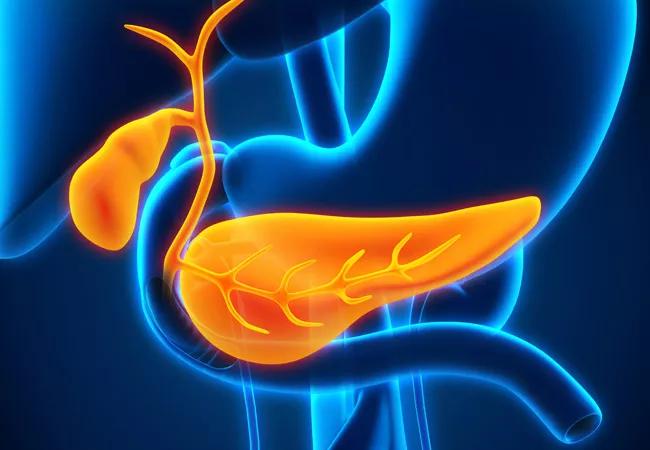
Extracorporeal shock wave lithotripsy (ESWL) is a noninvasive procedure originally developed to treat kidney stones and later applied to gallstones and pancreatic stones. It uses high-energy shock waves to break up calculi (stones) into smaller pieces so that they can pass through the body or become easier to extract.
Advertisement
Cleveland Clinic is a non-profit academic medical center. Advertising on our site helps support our mission. We do not endorse non-Cleveland Clinic products or services. Policy
Pancreatic stones are found in about half of patients with chronic pancreatitis (CP) and are especially common in patients with alcohol-related CP. Intraductal stones occur in the main ducts and side branches of the pancreas and are a major cause of abdominal pain because they can obstruct the outflow of pancreatic secretions, leading to increased intraductal pressure and ischemia.
“Our treatment goal with extracorporeal shock wave lithotripsy is to reduce pain and preserve or improve pancreatic function,” says fellowship-trained interventional endoscopist Tilak Shah, MD, Medical Director of the Pancreas Center at Cleveland Clinic Weston Hospital. Dr. Shah performed the first cases of ESWL for pancreatic stones at Weston Hospital earlier this year, making it one of the few centers in Florida now offering ESWL.
Standard treatment for patients with chronic pancreatitis, with or without duct stones, typically includes a low fat diet, pancreatic enzyme supplements, and pain medications.
For pancreatic duct stone management, the American College of Gastroenterology (ACG) guidelines recommend endoscopic drainage procedures, such as endoscopic retrograde cholangiopancreatography (ERCP), as the first-line option for pain due to pancreatic duct obstruction.
“Removal of pancreatic duct stones to decompress the duct with standard endoscopic tools is unfortunately very challenging,” says Dr. Shah. “ESWL allows the stones to be broken up into small pieces and increases the likelihood that endoscopic decompression procedures, like ERCP, will be successful.”
Advertisement
In fact, the European Society of Gastrointestinal Endoscopy (ESGE) guidelines recommend ESWL for stones greater than 5 mm, pointing to successful stone fragmentation in more than 90% of patients.
“Stone extraction methods generally depend on their size and location,” says Dr. Shah. “We can often remove smaller stones using an endoscopic technique like ERCP and then an extraction balloon to pull the stones out. For larger stones, ESWL can be used in conjunction with ERCP to help disrupt stones prior to endoscopic extraction or it can be used independently.”
ESWL works by concentrating focused electromagnetic shock waves on stones, causing them to fragment. Multiple sessions may be required to break up stones into small enough pieces to pass through the duct naturally or to be extracted endoscopically.
“Newer lithotripters, which generate the shock waves, use more targeted focusing systems to reduce collateral tissue damage and minimize complications associated with legacy systems,” notes Dr. Shah.
He points out that the most appropriate patient for ESWL are individuals with CP and large (> 5 mm) intraductal stones located in the head or body of the pancreas who are experiencing pancreatic insufficiency and/or pain. “ESWL is not used for stones in the tail of the pancreas due to the risk of damaging the spleen,” he adds.
One of the first patients to undergo ESWL at Weston Hospital was a 57-year-old male with CP who had pain, unintentional weight loss, and diarrhea. He was initially treated with pancreatic enzymes. Imaging revealed multiple stones in the parenchyma and a 7 mm stone in the main pancreatic duct. “We used lithotripsy to break up the ductal stone and then endoscopically removed the fragments,” describes Dr. Shah.
Advertisement
Another patient was a 47-year-old female with acute recurrent pancreatitis who had a 9 mm ductal stone in the head of the pancreas. She underwent ESWL, and the stone fragments were allowed to undergo natural expulsion.
“In both cases, the patients required only one round of treatment,” says Dr. Shah. “Neither experiencedcomplications, and they each had marked pain relief.”
Dr. Shah believes ESWL is currently underutilized in the United States because it can take longer to perform and requires expensive infrastructure.
“But for the right patient, it can be the right treatment,” he says. “ESWL is an effective and less invasive alternative to surgery for large stones and a promising approach for managing challenging cases. That makes it an important addition to the treatment options we can now offer our patients.”
The Pancreas Center at Weston Hospital is a National Pancreatic Foundation Center of Excellence, one of only four in Florida recognized for providing comprehensive, exceptional care for pancreatic cancer and pancreatitis. It includes a multidisciplinary team of gastroenterologists, pancreatic surgeons, radiologists, oncologists, nutritionists, and a genetic counselor experienced in caring for patients with complex pancreatic diseases.
For more information, visit Cleveland Clinic Florida ConsultQD. Subscribe to the Florida Physician Newsletter.
Additionally, follow us on X (formerly Twitter), Facebook, and LinkedIn.
Advertisement
Advertisement

Cleveland Clinic Weston Hospital’s collaborative model elevates care for complex lung diseases

Interventional pulmonologists at Cleveland Clinic Indian River Hospital use robotic technology to reach small peripheral lung nodules

Trained in the use of multiple focal therapies for prostate cancer, Dr. Jamil Syed recommends HIFU for certain patients with intermediate-risk prostate cancer, especially individuals with small, well-defined tumors localized to the lateral and posterior regions of the gland.

Cleveland Clinic Weston Hospital is actively recruiting patients for an international, multicenter, phase III study comparing MIS versus open interval cytoreduction following neoadjuvant chemotherapy in patients with stage IIIC-IV epithelial ovarian cancer.

Urologic oncologist with Cleveland Clinic in Florida performs robotic-assisted retroperitoneal lymph node dissection.

Cleveland Clinic researchers in Florida identify unexpected survival benefit

Noninvasive, radiation-free imaging supports treat-to-target IBD care

Cleveland Clinic in Florida transplant specialists perform advanced surgical approach for living kidney donation